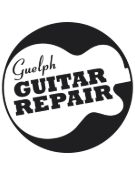Gibson LG0
Grace Da Maren

This guitar, like so many, has a sweet story. My client told me it belonged to her grandmother, and it was due for some major love to make it play again.
The body was heaving up or 'bellying'. The bridge was attached to the body by a few bolts and nuts, and over time, that really allowed it to pull the soundboard upward, increasing the action and making it no fun to play.
Once I removed the bridge, I flattened the top with heat and moisture. I've got some cauls perfect for this job. One is shaped like the bridgeplate inside the guitar, and is slighty concaved. The other is shaped to match the footprint of the bridge, and is slightly convexed. When I heat those babies up and clamp them around the (slightly dampened) bridge area, I can really encourage the belly into a flatter shape. It took 2 sessions for this beauty. When the top was as flat as I could make it, I addressed the crack down the centre seam. I cleared out old dirt from the crack, reglued it with titebond, and sealed the area up with a couple light coats of brushed on shellac.
On the inside, things looked pretty good! I had one brace on the top and one on the back to reglue. The roughest spot of the internal structures was the bridgeplate. The bridgepin holes were pretty chewed up. I filled the missing spots with epoxy, then made a plate to reinforce and beautify it.
The bridge, as mentioned earlier, was still original, and bolted on, so removing it was as easy as remembering what way is lefty-loosey, when my hand was inside the guitar. A nice way to improve the sound of the guitar, and also prevent future bellying, was to make a new, ebony bridge. I traced the old one, figured out the bridgepin hole locations, drilled, shaped, and glued on the new bridge. The final step was to route a slot for the saddle. I gave it a try with my dremel,. The tool wandered a bit, and I panicked, and brought it to my mentor, Mike, who made fixing the issue I'd made seem like a breeze. It always helps to get an experienced set of eyes on a problem when my heart is racing.
I gave the frets a Level-Crown-Polish, and spent extra time on the fretboard past the 12th fret. There was a hump causing me grief. Combined with 2 rounds of a heat press on the neck, we reached a setup with great playability. New tusq bridgepins were the last touch to this awesome instrument!
Taking a beloved instrument and transforming it into a beloved instrument that plays GREAT is my joy, and client feedback afterward is what fuels me. Here's what my client had to say, a few weeks after reuniting with her grandmother's guitar.
It is playing so great. Everyone in my family was super excited to see it fixed, it was an old memory. That guitar hasn’t been played since before I was born. It plays really well now, I hope to keep it playing well as long as it will hold up, and it’s perfect size for me haha. Thanks so much for fixing it up so well!
Some guitar repair journeys are not linear. Remember that you can bring your guitar to me for an inspection and assessment, then budget for the future repairs. When I assessed this guitar, my estimate was outside of my client's budget at the time. She deferred the work until the month that she could afford it, and we got it wrapped up just in time for Christmas!
If you've got an old guitar that needs some love and elbow grease, please call me. I love this stuff!
December2023






